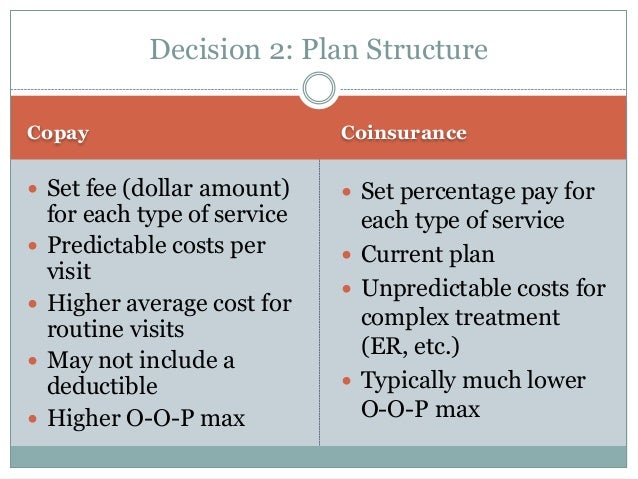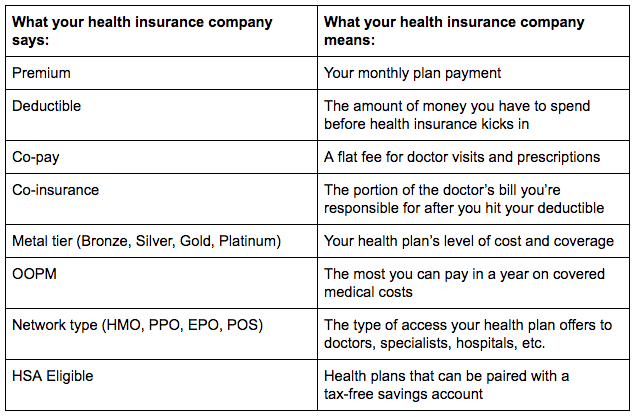Health care terms can be confusing. But when it comes to payment types, it’s helpful to know the meaning of the different terms so you know what form of payment is required. The most common types are copays, deductibles, and coinsurance. All three are different types of cost sharing, which is the portion you pay for a medical service or prescription drug.
Coinsurance The percentage of costs of a covered health care service you pay (20%, for example) after you've paid your deductible. Let's say your health insurance plan's allowed amount for an office visit is $100 and your coinsurance is 20%. If you've paid your deductible: You pay 20% of $100, or $20. You may also have a copay after you pay your deductible, and when you owe coinsurance. Your Blue Cross ID card may list copays for some visits. You can also log in to your account, or register for one, on our website or using the mobile app to see your plan’s copays.
What is a copay?
A copay is a fixed amount you pay for a health service, seeing your doctor, or filling a prescription. Copays cover your cost of a doctor’s visit or medication. You may not always have a copay, however. Your plan may have a $0 copay for seeing your doctor, for example, in which case you would not have to pay a copay each time you visit your doctor.

What is a deductible?
A deductible is the amount you pay for a service before the plan shares the cost of the service with you. There could be a deductible on medical services or on prescription drug services, but not all plans have a deductible. For example, if your plan had a $200 prescription drug deductible, you would pay the first $200 of your prescription drug costs before your plan helps to pay. If your plan had a $0 prescription drug deductible, your plan would help pay for your prescription drug costs without you having to pay a certain amount first.
What is coinsurance?
Coinsurance is when you pay a percentage of the cost for an item or service. For example, if a medical service has a 20 percent coinsurance, you would pay 20 percent of the cost and your plan would pay the other 80 percent. Coinsurance is when you and your plan both share a percentage of the cost of a service that adds up to 100 percent.
For more information on common health care terms, use this helpful glossary.
Want more health and wellness articles, and other important health updates?
Sign up to receive them directly to your inbox here!
You might also be interested in ...
Referrals Are Central to Your Care
Referrals are an important part of an HMO plan because they help your doctor keep track of the care you receive and ensure that the care is right for you.
Read moreA copay is your share of a medical bill after the insurance provider has contributed its financial portion. Medicare copays (also called copayments) most often come in the form of a flat-fee and typically kick in after a deductible is met.
A deductible is the amount you must pay out of pocket before the benefits of the health insurance policy begin to pay.
Understanding Medicare Copayments & Coinsurance
Medicare copayments and coinsurance can be broken down by each part of Original Medicare (Part A and Part B). All costs and figures listed below are for 2021.
Medicare Part A
After meeting a deductible of $1,484, Medicare Part A beneficiaries can expect to pay coinsurance for each day of an inpatient stay in a hospital, mental health facility or skilled nursing facility. Even though it's called coinsurance, it operates like a copay.
- For hospital and mental health facility stays, the first 60 days require no Medicare coinsurance
- Days 61 to 90 require a coinsurance of $371 per day
- Days 91 and beyond come with a $742 per day coinsurance for a total of 60 “lifetime reserve' days
These lifetime reserve days do not reset after the benefit period ends. Once the 60 lifetime reserve days are exhausted, the patient is then responsible for all costs.
For a stay at a skilled nursing facility, the first 20 days do not require a Medicare copay. From day 21 to day 100, a coinsurance of $185.50 is required for each day. Beyond 100 days, the patient is then responsible for all costs.
Under hospice care, you may be required to make copayments of no more than $5 for drugs and other products related to pain relief and symptom control, as well as a 5% coinsurance payment for respite care.
Under Part A of Medicare, a 20% coinsurance may also apply to durable medical equipment utilized for home health care.
Medicare Part B
Once the Medicare Part B deductible is met, you may be responsible for 20% of the Medicare-approved amount for most covered services. The Medicare-approved amount is the maximum amount that a doctor or other health care provider can be paid by Medicare.
Some screenings and other preventive services covered by Part B do not require any Medicare copays or coinsurance.
Understanding Medicare Deductibles
Medicare Part A and Medicare Part B each have their own deductibles and their own rules for how they function.
Medicare Part A
The Medicare Part A deductible in 2021 is $1,484 per benefit period. You must meet this deductible before Medicare pays for any Part A services in each benefit period.
$30 Copay After Deductible

Medicare Part A benefit periods are based on how long you've been discharged from the hospital. A benefit period begins the day you are admitted to a hospital or skilled nursing facility for an inpatient stay, and it ends once you have been out of the facility for 60 consecutive days. If you were to be readmitted after 60 days of being home, a new benefit period would start, and you would be responsible for meeting the entire deductible again.
Medicare Part B
The Medicare Part B deductible in 2021 is $203 per year. You must meet this deductible before Medicare pays for any Part B services.
Unlike the Part A deductible, Part B only requires you to pay one deductible per year, no matter how often you see the doctor. After your Part B deductible is met, you typically pay 20 percent of the Medicare-approved amount for most doctor services. This 20 percent is known as your Medicare Part B coinsurance (mentioned in the section above).
Cover your Medicare out-of-pocket costs
There is one way that many Medicare enrollees get help covering their Medicare out-of-pocket costs.
Medigap insurance plans are a form of private health insurance that help supplement your Original Medicare coverage. You pay a premium to a private insurance company for enrollment in a Medigap plan, and the Medigap insurance helps pay for certain Medicare out-of-pocket costs including certain deductibles, copayments and coinsurance.
The chart below shows which Medigap plans cover certain Medicare costs including the ones previously discussed.
Click here to view enlarged chartScroll to the right to continue reading the chart
Medicare Supplement Benefits
Do You Pay A Copay After Deductible
Part A coinsurance and hospital coverage
Part B coinsurance or copayment

Part A hospice care coinsurance or copayment
First 3 pints of blood
Skilled nursing facility coinsurance
Part A deductible
Part B deductible
Part B excess charges
Foreign travel emergency
| A | B | C* | D | F1* | G1 | K2 | L3 | M | N4 |
|---|---|---|---|---|---|---|---|---|---|
| 50% | 75% | ||||||||
| 50% | 75% | ||||||||
| 50% | 75% | ||||||||
| 50% | 75% | ||||||||
| 50% | 75% | 50% | |||||||
| 80% | 80% | 80% | 80% | 80% | 80% |
* Plan F and Plan C are not available to Medicare beneficiaries who became eligible for Medicare on or after January 1, 2020. If you became eligible for Medicare before 2020, you may still be able to enroll in Plan F or Plan C as long as they are available in your area.
+ Read more
Do You Still Pay Copay After Deductible Is Met
1 Plans F and G offer high-deductible plans that each have an annual deductible of $2,370 in 2021. Once the annual deductible is met, the plan pays 100% of covered services for the rest of the year. The high-deductible Plan F is not available to new beneficiaries who became eligible for Medicare on or after January 1, 2020.
2 Plan K has an out-of-pocket yearly limit of $6,220 in 2021. After you pay the out-of-pocket yearly limit and yearly Part B deductible, it pays 100% of covered services for the rest of the calendar year.
3 Plan L has an out-of-pocket yearly limit of $3,110 in 2021. After you pay the out-of-pocket yearly limit and yearly Part B deductible, it pays 100% of covered services for the rest of the calendar year.
4 Plan N pays 100% of the Part B coinsurance, except for a copayment of up to $20 for some office visits and up to $50 copayment for emergency room visits that don’t result in an inpatient admission.
- Read lessIf you're ready to get help paying for Medicare out-of-pocket costs, you can apply for a Medigap policy today.
Find Medigap plans in your area.
Find a plan$65 Copay After Deductible
Resource Center
Enter your email address and get a free guide to Medicare and Medicare Supplement Insurance.
$30 Copay After Deductible Means
By clicking 'Sign up now' you are agreeing to receive emails from MedicareSupplement.com.
We've been helping people find their perfect Medicare plan for over 10 years.
Ready to find your plan?

Comments are closed.